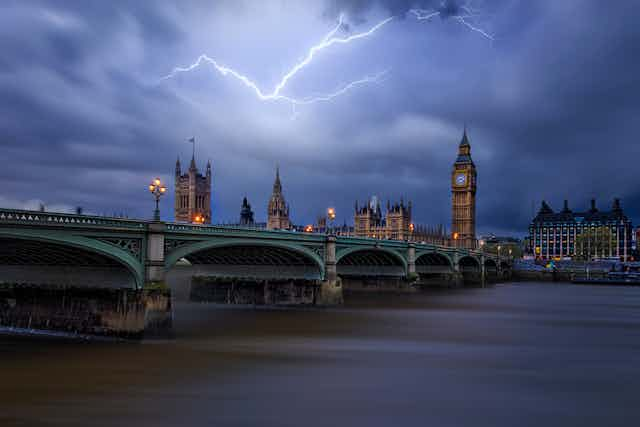The House of Commons recently flooded, right in the middle of a debate. As Conservative MP Justine Greening discussed unpaid tax and national insurance, she was interrupted by a cascade of water coming through the ceiling and the sitting was suspended 10 minutes later.
As water poured down through the roof on to the press gallery, it was hard not to make the connection between the broken building and a broken institution. Parliament’s failure to come to a consensus on Brexit has demonstrated that the institution is broken. That is not unrelated to the derelict state of the building itself. This moment offers a once-in-a-generation opportunity to reconnect a disaffected population with parliament.
The ongoing project to restore the Palace of Westminster could be used to address the longstanding cultural issues within parliament that promote embedded power dynamics and adversarial behaviour.
Brexit has only amplified the public’s disaffection with British politicians which was already considerable after the MPs’ expenses scandal. Children’s author Philip Pullman encapsulated this frustration and disillusionment recently when he tweeted that the whole building should be “exploded” and rebuilt from scratch, adding: “Much of our diseased politics is embodied in that building.”
By the middle of the next decade part of Pullman’s wish is due to come true. MPs and Lords have agreed to leave the palace entirely so it can be rebuilt in their absence. Much of the essential infrastructure serving the building dates back to the 19th century and passed its expected lifespan decades ago. Indeed, the recent flood came as no surprise: in September 2016 a Joint Select Committee warned that the palace “faces an impending crisis which we cannot responsibly ignore”.
Nor is the risk limited to flooding. There are regular small fires, caused by the outdated infrastructure, which have the potential to turn into major incidents. Wardens patrol the building 24 hours a day to manage the problem. Inside the building asbestos is widespread and outside masonry is crumbling – a “football-sized lump” has fallen off a stone angel on the Victoria Tower.
As a Grade I listed building and part of a UNESCO World Heritage Site, the palace cannot be torn down – or “exploded” as Pullman suggested. As for moving elsewhere, a decision was taken in 2012 by the governing bodies of the Commons and Lords that “ruled out the option of constructing a brand new building away from Westminster”. This decision was taken with no public consultation, or consideration of the potential costs or benefits of a new building.
Throughout our research, we’ve spoken to many parliamentarians who are concerned about the restoration project. Current estimates for the project are at least £3.5 billion and possibly much more (the cost estimates date back to 2014, and are expected to increase when a final budget is produced next year). The concern is that it may be difficult to justifying spending billions of taxpayers’ money on politicians, especially at a time of national austerity. But this fear may be unfounded – polling suggests the public is broadly positive about the need to rebuild the palace.
The project is nevertheless dominated by a negative mindset. It is called a “restoration and renewal” programme but it is currently aimed solely at protecting the heritage of the building (the restoration), rather than the prospects of creating a parliament for the 21st century (the renewal). The physical fabric of the building is not currently a welcoming or open space. The programme has focused on repairing the crumbling infrastructure rather than addressing the masculine and adversarial design, which itself fails to promote openness to the public.
The project’s focus on the past may be because there is no clear single vision of what a future parliament should look like: it is a question that cannot be answered without a wide-ranging and imaginative public debate.
There have lately been a few positive steps in this direction. A joint select committee has recommended that public engagement must be an integral part of the restoration and renewal programme. As the group notes, “the country is evolving and so must the building in which the most important decisions which touch upon every member of the population are made”. Parliament’s handling of Brexit has exasperated and frustrated the public, not least because of confusing parliamentary procedures. The restoration and renewal programme is an opportunity to redesign an institution and open up the processes of parliament to the people it serves.
Before the ill-fated Commons sitting was suspended, and as he struggled to make himself heard over the gushing water, Labour MP Justin Madders suggested the flood offered “symbolism … about how broken parliament is”. Public engagement is necessary in order to fix a decaying parliament. The restoration and renewal programme is a key opportunity for positive engagement with a democracy that looks to the future instead of the past, encouraging discussions about openness, collaboration and inclusivity.

